7 Things to Consider Before Your Next Discovery Call
For any sales rep, picking up the phone to perform a discovery call is daunting.
Even the most experienced reps consider discovery calls to be redundant, and sometimes awkward.
But because discovery calls are a critical part of the sales process, it’s important to know what to say, and what to avoid.
Our data team at Gong.io analyzed 519,291 sales conversations to discover what makes a great discovery call, and how top reps determine whether or not the buyer on the other end is a good fit.
So, before you hop on the phone with your next prospect, here are a few things to consider…
[newsletter]
1. Know Your Prospect’s History
The person on the other line of your discovery call is (hopefully) about to embark on a voyage that will end with them buying what you sell.
But before you can navigate those closing call waters, you should know a bit about your prospect’s backstory.
There are countless places to research a prospect before a sales call — most of which being online.
With an abundance of details and data in your CRM, along with social media channels that can be easily leveraged, it should be impossible for you to show up to the call ignorant of what’s happening in your prospect’s world.
Even go as far as roleplaying what they’re thinking, so you’re caught up with the conversation that’s already taken place in their mind.
2. Come Prepared to Address Problems
It’s common for many sales reps to dive directly into pain points for their initial part of discovery.
However, the most informative conversations start with understanding plans for the business and then getting straight to the bottom line.
Chances are, your prospect is not on the phone with you to investigate your product out of academic curiosity.
So, don’t be afraid to straight up ask, “What’s causing you to consider us?” and then continue to build rapport.
Successful salespeople tend to talk about rapport-related topics at the beginning of sales calls, dive deeply into 3 to 4 customer problems, and then wrap up logistics and next steps at the end.
Why 3 to 4?
Looking at more than that makes all the problems seem less urgent.
You also run the risk of your prospect losing interest.
Discussing 3-4 problems has the highest likelihood of moving the deal to the next step: 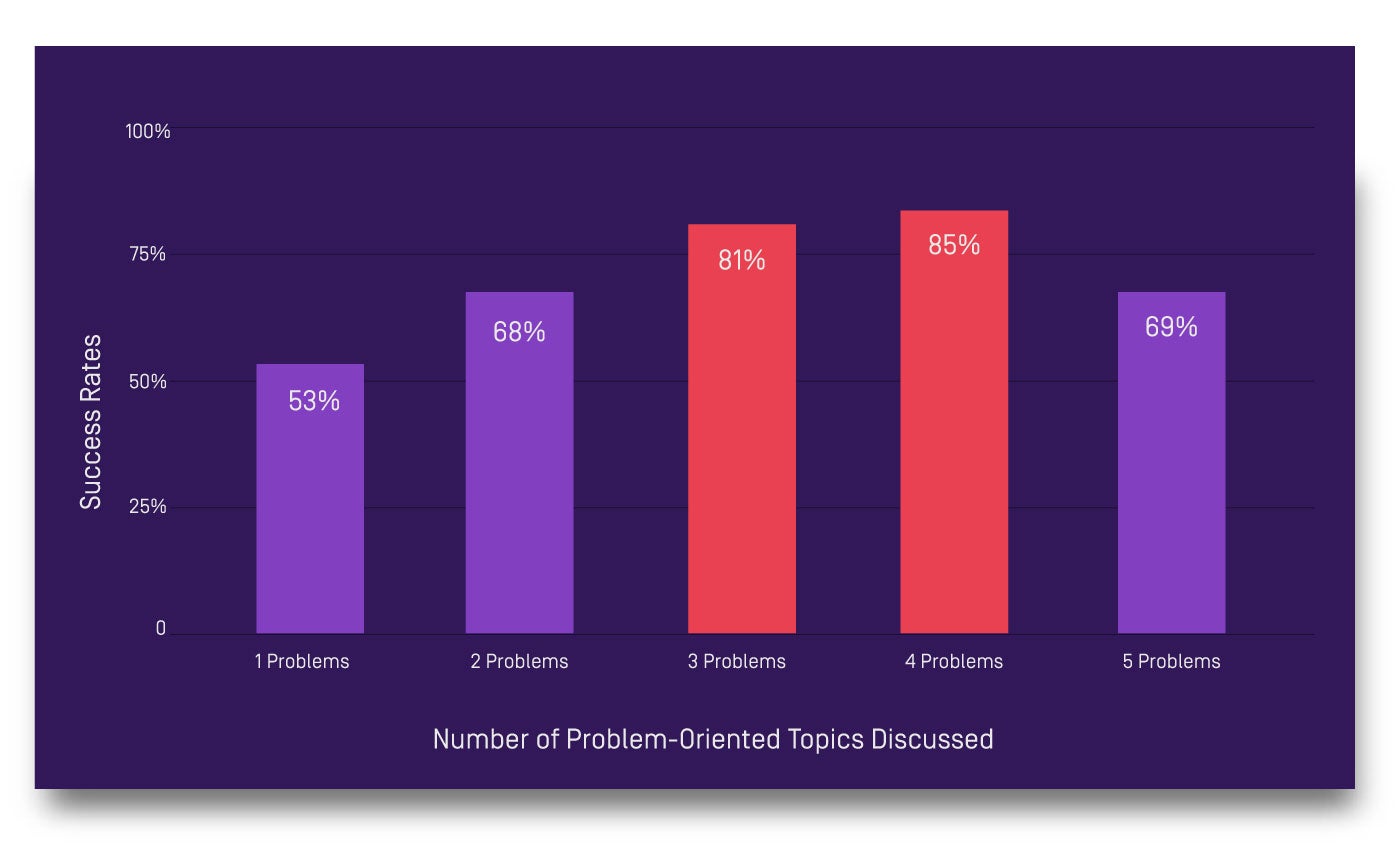
3. Ask 11-14 Targeted Questions
When you’re unpacking those problems with the prospect, ask around 11-14 questions in total.
If you go beyond 14, you’re likely to see a diminishing rate of return.
And, if you go fewer than 11, you won’t go deep enough to uncover useful information:
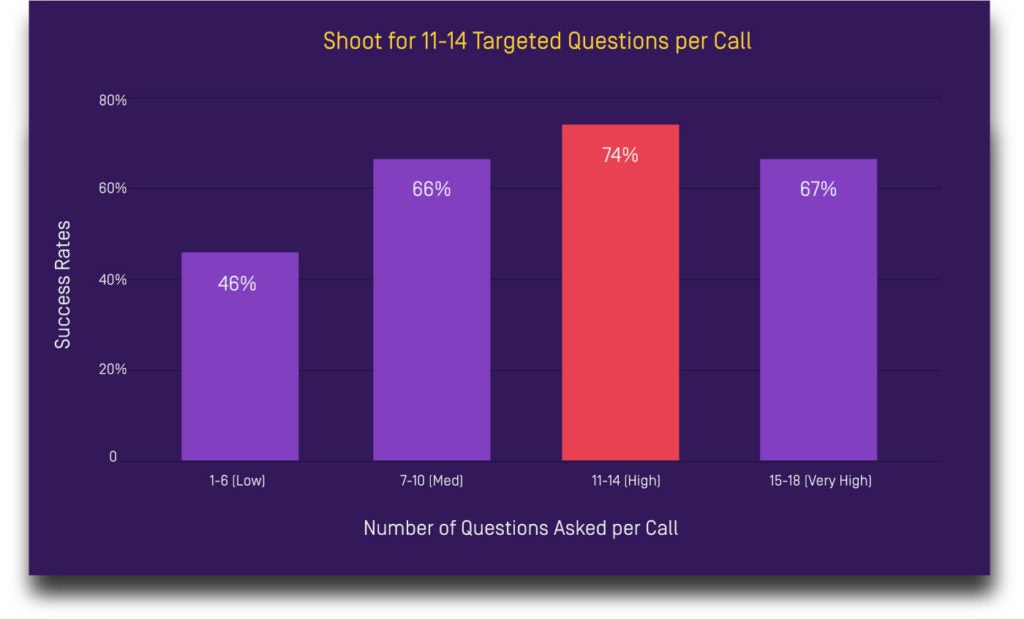 Most importantly, the types of questions you ask matter.
Most importantly, the types of questions you ask matter.
Questions specifically asked about the customer’s business issues, challenges, goals, and areas of relevant concern have a stark relationship to bringing the deal across the finish line.
In other words, for an effective discovery sales call, don’t just ask more questions; ask more targeted questions.
4. Work with Your Prospect to Outline Their Goals
Once you have a good idea of the state of your prospect’s business, it’s time to learn more about the buyer’s goals.
Identify which personas are part of the buying committee, and know the ins and outs of their individual goals.For example, if your prospect is a B2B sales leader, you can ask questions like:
- Are you losing deals?
- Are you not growing?
- Are your competitors outperforming you?
- Are your distributors pressuring you to increase volume?
- Is there a chance you might lose exclusivity?
You should also be on the lookout for short-term versus long-term goals.
Are they trying to reach their goals this quarter, or this year?
From there, you can ensure your solution fits their needs in a timely manner.
5. Listen More Than You Talk
Top performers listen more to their prospects with a talk-to-listen ratio of 46:54 during discovery calls:
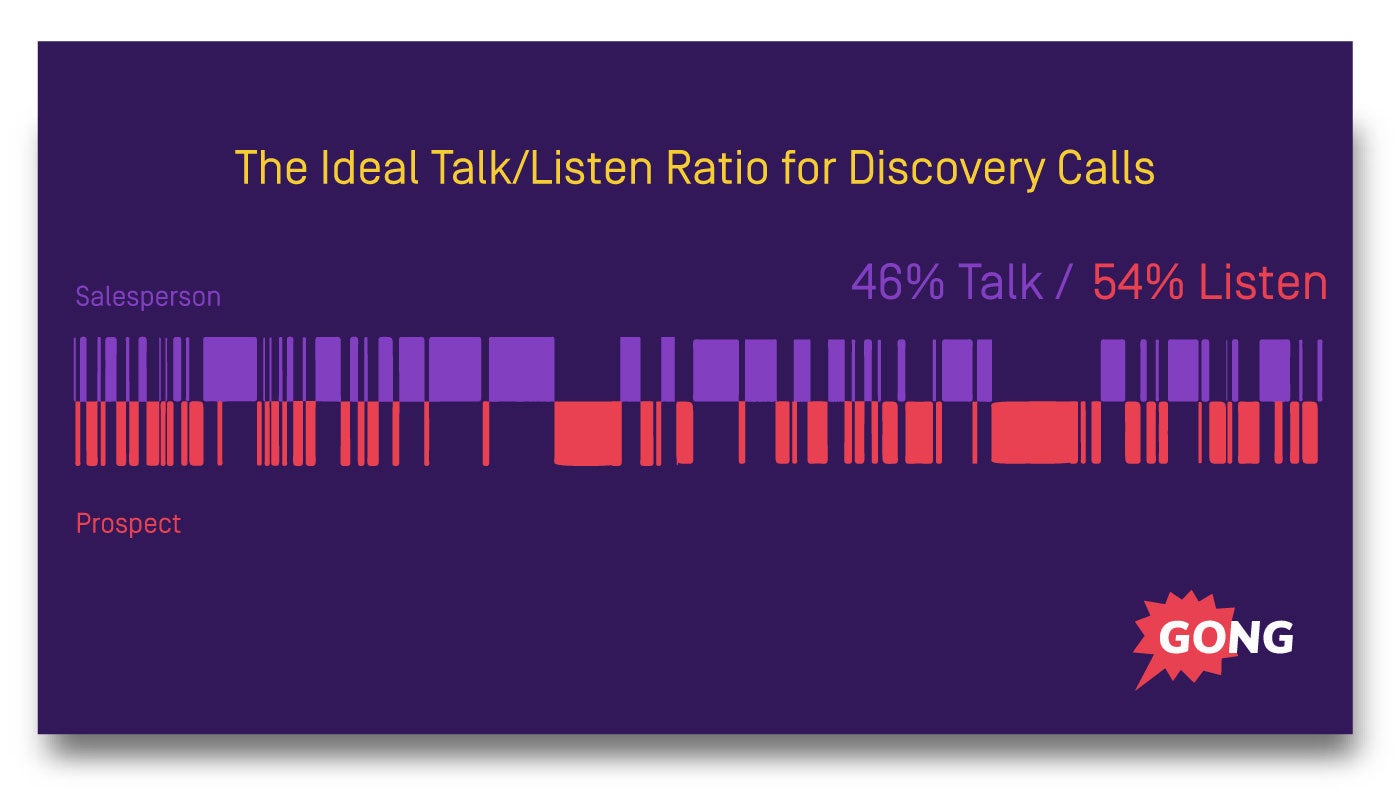
The talk/listen ratio correlates directly to success, with average and low performers talking far more than top performers:
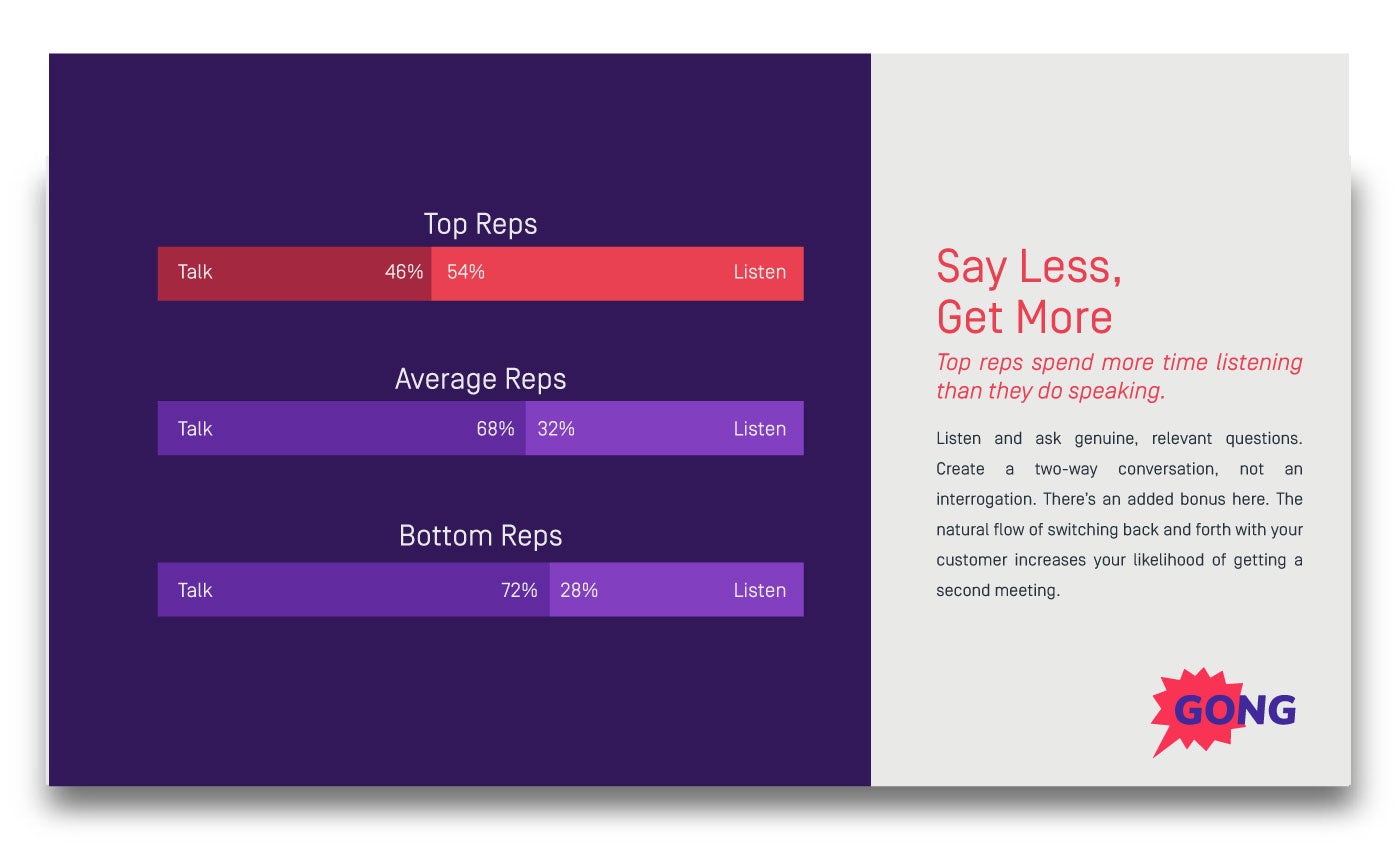
6. Keep the Conversation Flowing
While it can be tempting to front-load your questions to the beginning of a call, it can actually hurt you in the long run.
Think about it…
If you were on the receiving end, you wouldn’t want to be bombarded with interrogation.
Top performers ask questions as they come up throughout the entire discovery call.
On the other hand, those average performers have the tendency to ask all of their questions at the begging of a call:
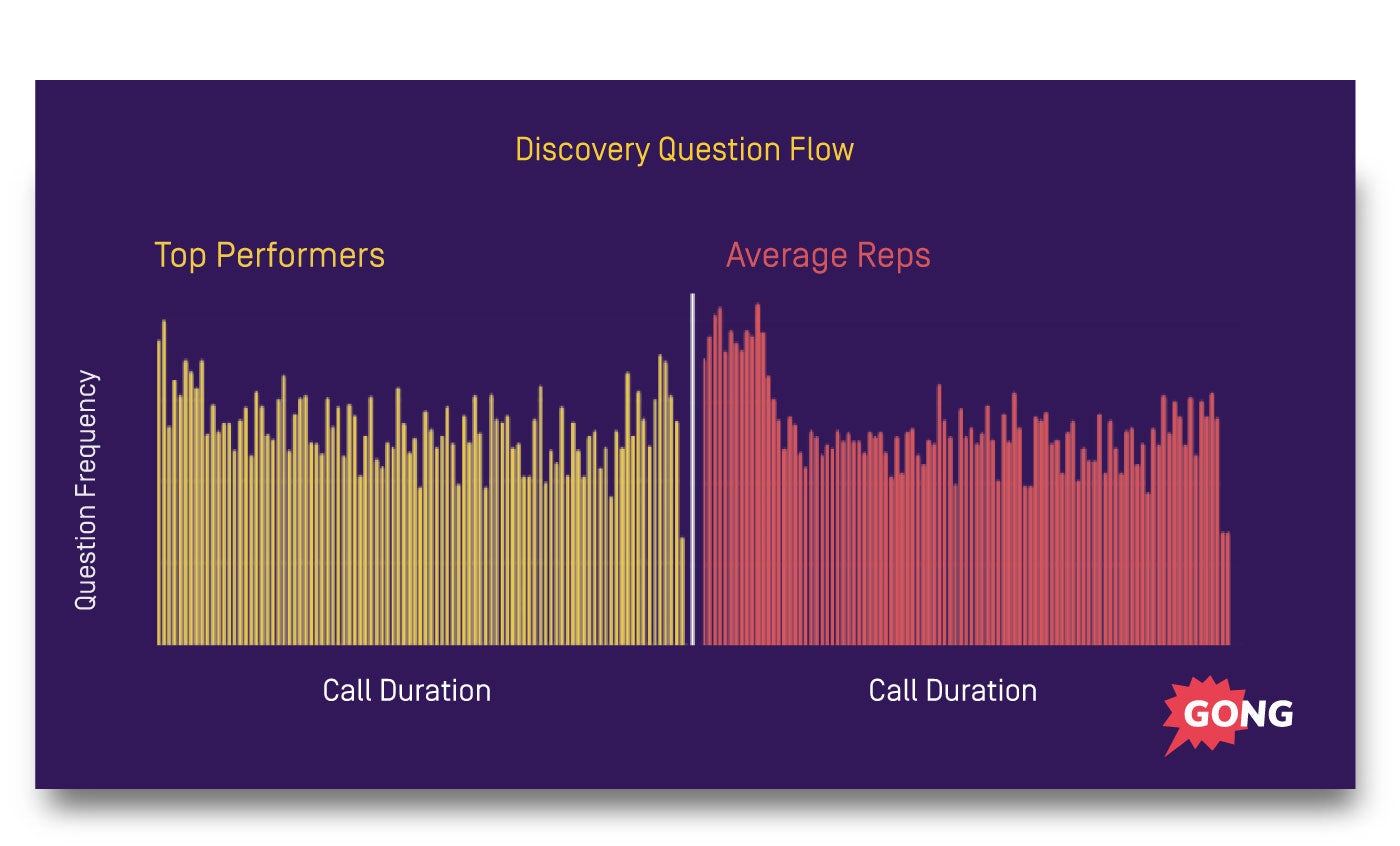
At the end of the day, front-loading questions makes you sound like you’re carelessly going through a checklist.
Instead, strive to create natural fluidity by listening and asking genuine and relevant questions.
7. Schedule early in the week and late in the day
When it comes to scheduling your first meeting with a prospect, no-shows are inevitable.
Take your own calendar for example.
It’s probably filled with meetings and appointments.
Your prospect’s calendars are undoubtedly very similar.
Because discovery calls are the crucial first step of your sales process, you should limit the likelihood of no-shows and give yourself the best opportunity for success.
Usually, time of day and day of the week factor directly into successful discovery call connections.
In what ways?
For starters, the highest number of no-shows is early in the day.
First thing in the morning, your prospect’s personal concerns are more top of mind. This makes it easier for scheduled calls to slip through the cracks.
In turn, the magic time slot for hosting meetings (or dialing in using call software) is when schedules start to calm down around 3 pm.
This allows your prospect to fulfill not only their morning routine, but lunch, and the post-lunch rush.
By 3 pm, people may actually be looking for a break from their regular day-to-day activities.
You’ll also get the benefit of knowing that you’re showing them a product that will make their days easier.
In terms of days of the week, do your best to avoid Fridays.
Monday is the day with the highest call attendance, with Wednesday a close second.
Even though your prospect is likely coming reeling down from the weekend, most people take care of anything left over from the previous week Monday morning.
And by Monday afternoon, prospects are likely ready to take on new tasks.
That means, it’s time to focus on their checklist for the week, which may or may not include a discovery call with you ;)
As the week comes to a close, your discovery call no-show rates are likely to be affected by end-of-week celebrations.
Don’t let your prospect’s weekend plans get in the way of you having a call with them.
Mapping Out Your Prospect’s Pain Points After Your Discovery Call
How do you know if your discovery call was successful?
If you have a follow-up call scheduled on the calendar, the answer should be pretty clear.
As you move into the stages following a discovery call, consider pain mapping your prospect’s list of concerns.
Just as user experience teams use customer journey maps to solve issues with a product, sales teams can follow a similar approach.
After your discovery call ends, think about how you can start solving the problems they’re facing.
As you begin the mapping process, know the difference in variants of pain that you’ve uncovered during their discovery call.
Surface pains are things that seem straightforward (i.e. trying to grow revenue, but missing revenue targets).
Core pain goes much deeper – if a prospect is trying to grow their business but failing, these problems surface as people start getting fired and divisions begin shutting down.
At the end of the day, the impacts of pain make your prospects emotional. When you take the time to map the pain from the surface to the core, your prospects will have a real reason (fueled by both logic and emotion) to make a purchase.
Want to share these deal-closing insights with the rest of your team?
Download our free Discovery Call Cheat Sheet here!
